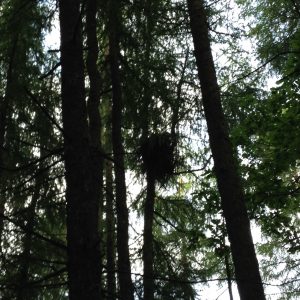NEW HORIZONS
TWO
“I got my new horizons out to see”
With the Moodies already in the back of my mind, it was no surprise that this lyric from a classic Hayward track hummed away as we drove down the M50 to mid Wales.There we were to spend a few days at Garddfady Farm home of Barbara’s sister Jill and husband Hywel The countryside around there is lush. Wooded with oaks and conifers, it is crisscrossed with hedges and streams and patchworked with grassy green meadows. Four large oaks straddle the farm land and are so monumental that I wondered just how old they were. A long piece of string revealed the girth of one to be 207 inches which the Woodland Trust website formula translated into an age of 320 years. Garddfady’s oaks were thus planted in the late seventeenth century between the end of the English civil war and the first Jacobite rebellion in Scotland. In good health their acorns were self setting all over the meadow below. I set about rescuing them from the nibbling of sheep and potted them up ready for replanting beneath a new Scottish horizon.
For those of a religious persuasion it would come as no surprise to learn that this rural idyll was once the home and inspiration for the ‘sweet singer of Wales’, William William Pantycelyn. Otherwise known as Holy Hollow, Pantycelyn is the name of the farm in which this preacher lived and died. It was there that he nurtured his Calvinist -Methodist beliefs and from where he ventured out to proselytise throughout Wales. Over 48 years his journeys covered 150.000 miles. All the while his religiosity was crystallized in the hymns he composed, the lyrics often drawn from the natural world around him.
When I was thirteen and a pupil at Chipping Norton Comprehensive School all the third year boys gathered for an afternoon’s ‘music’ lesson. I say music but what it actually meant was that for around forty minutes we engaged in a collective singalong of songs such as ‘Men of Harlech’ and ‘Molly Malone’. Hymns featured too with the one we knew as ‘Bread of Heaven’ guaranteed to raise the roof of that small room. Fifty years later I was part of a 70.000 rugby throng which raised the roof of the Millennium stadium with the same hymn. It is number 296 in the Book of Common Prayer and more properly known as ‘Guide me O thou great Jehovah’ and is William Williams Pantycelyn’s most famous work: in lay terms, his greatest hit.
“Bread of heaven
Feed me now and evermore”
The locality was for Williams a kind of heaven on earth constantly replenishing him particularly by way of the bird song which bursts out from all the holy hollows. Indeed one commentator refers to it as his own “heavenly choir”. Wordsworth too was similarly inspired. He praises the cuckoo and its
“two fold shout …….. babbling only to the vale
Of sunshine and flowers
Thou bringest unto me a tale
Of visionary hours.”
A few days here and one could see why Williams and Wordsworth would write such words. Whether Calvinist-Methodist, Pantheist or just plain Naturalist the variety of birdsong was indeed a delight. While cuckoos called from deep within the dense woods, blackcaps, willow and wood warblers, whitethroats, robins, blackbirds and song thrushes all made up the choir nearer by.
Readers of an earlier article will know that here at the edge of the Brecon Beacons red kite are a frequent sight. On this visit we were treated to several displays of their aerial
mastery. On one occasion from the heights of the Halfway or Crychan forest we were able to look down on a kite as it rode the air over the valley below, its forked tail and orange sheen in full view. Unbeknown to me though another bird of prey frequents the area; the equally impressive yet more secretive Goshawk. This fact was disclosed to me by my brother in law Hywel who had learned of their presence from his builder friend, Tony. Tony was well informed because his friend, Junior, was an authority on the bird. Such is the fellowship amongst birdwatchers, Tony offered to introduce us to him.
Herman or Junior is a tree surgeon and renowned authority on birds of prey. Following in his father’s footsteps, Junior’s calling is to find, count and ring Welsh Goshawks. of which he proudly told us are now plentiful. A two week period in recent years saw him log forty five nests. “Would I like to see one?”, he asked. Well imagine my delight. I had read the books of course (see earlier article) but never dreamt I could actually get close to this elusive bird. off we went to a larch wood which clung to the side of the Afon Gwydderig valley. There we located the nest high up in a larch tree. We were able to observe it from a slightly higher vantage point on the valley side. It became apparent that the small white flecks which periodically showed themselves amidst the dark tangle of nest sticks were in fact two chicks.Wow! We watched them twist and turn in the nest as the host tree gently swayed. Junior and I went down the slope to view the nest from below. While he looked for feathers for me I scanned the canopy above. Unbelievably a parent bird silently glided over the tree
tops and disappeared. I had been lucky. Junior said that visits to the nest with food are infrequent as little as twice in a thirteen hour period. I thanked him for giving me a major ‘bird’ moment. He said he was glad to have been able to share his passion with a fellow enthusiast. I thanked Hywel for having such good friends. Between them, Hywel, Tony and Junior had pulled together and opened up a major bird horizon’ for me.
As for the other bird moment over the four days, hearing the ‘heavenly choir,’ well for that I was well attuned. How? The answer will come as no surprise to regular readers. My small teenage record collection contained two EP’s or extended players. One was Twist and Shout by the Beatles, the other a collection of songbird and warbler songs by the legendary recordist Ludwig Koch.


